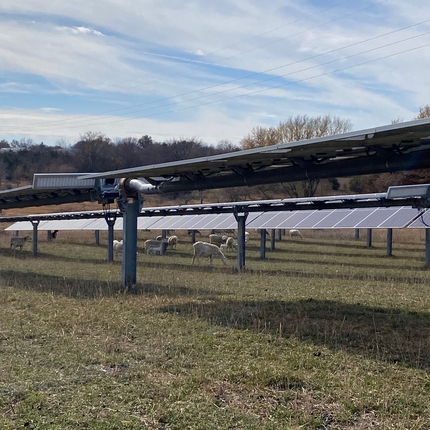Heidi Kolbeck-Urlacher, policy manager, [email protected], 605.240.0039; or Rhea Landholm, communications manager, [email protected] or 402.687.2100, ext. 1025
LYONS, NEBRASKA – As demand for clean energy increases, many state and local governments are prudently discussing the impact future solar development will have on agricultural lands.
Because large-scale solar requires considerable land use, a new report from the Center for Rural Affairs (produced for NCAT’s AgriSolar Clearinghouse) aims to provide decision-makers and others an overview of policy approaches they can take to combine solar with agriculture—a practice known as agrisolar or agrivoltaics.
Heidi Kolbeck-Urlacher, policy manager for the Center and author of the report “Policy Approaches for Dual-Use and Agrisolar Practices,” said clean energy and agriculture do not require an either/or approach.
“Combining agriculture and solar energy systems on the same land creates both economic and environmental benefits,” she said. “This includes offering new income streams to local farmers, improving soil health, and increasing beneficial pollinators. It can also expand siting opportunities for solar deployment.”
Agrivoltaics practices can include solar co-located with crops, grazing, beekeeping, pollinator habitat, aquaculture, and farm or dairy processing.
The report also examines the amount of land expected to be impacted by the rapid increase in solar development, and the opportunities available to encourage or facilitate keeping this land in agricultural dual-use through policy mechanisms at the federal, state, and local levels.
“Through thoughtful planning, decision-makers can craft policies that allow communities to take advantage of the economic benefits of solar development, such as increased tax revenue, while at the same time preserving the agricultural values of the local community,” Kolbeck-Urlacher said.
To learn more, view and download the “Policy Approaches for Dual-Use and Agrisolar Practices,” report at cfra.org/publications or through NCAT’s AgriSolar Clearinghouse, agrisolarclearinghouse.org.
This material is based upon work supported by the U.S. Department of Energy’s Office of Energy Efficiency and Renewable Energy (EERE) under the Solar Energy Technologies Office Award Number DE-EE0009372.



